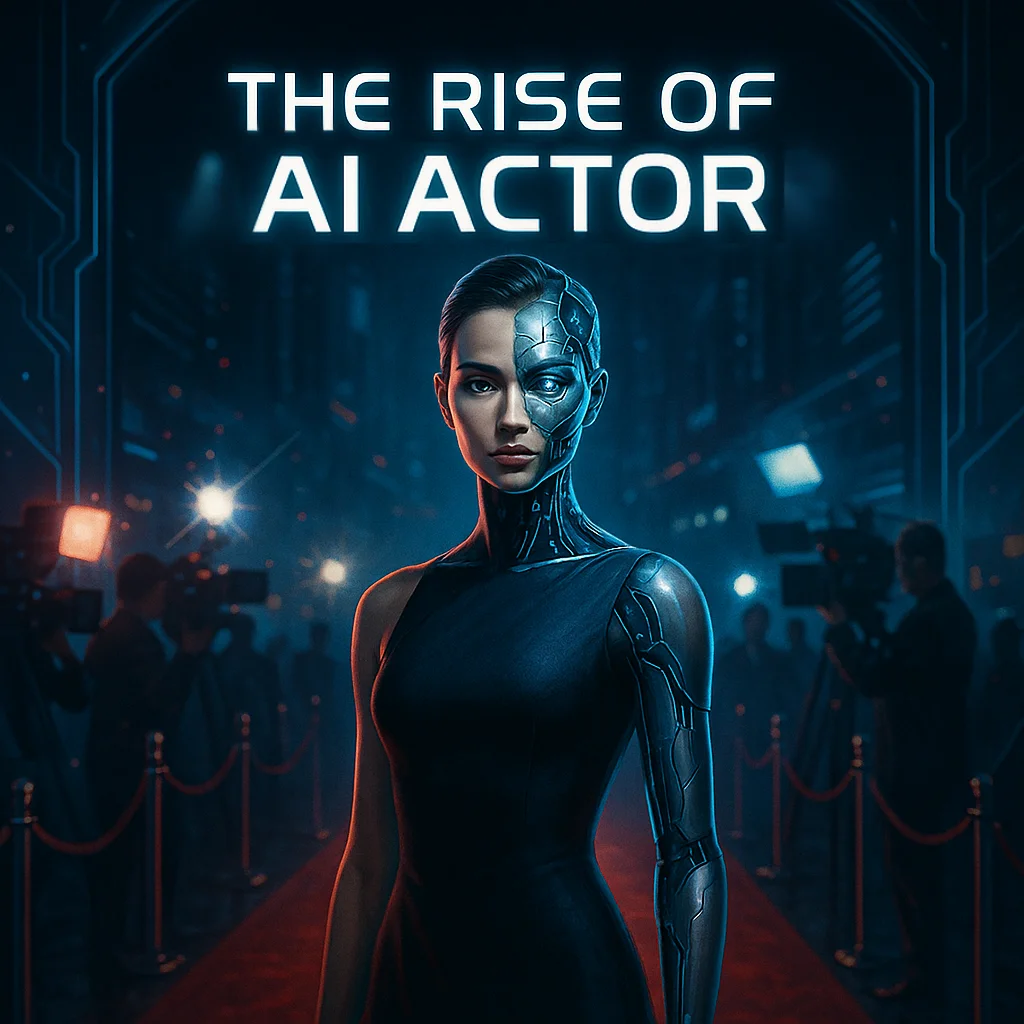Quick Summary
- Tilly Norwood is presented as the first full‑AI “actor” made by a studio called Xicoia, under Particle6.
- Her debut has sparked major debate in Hollywood: both excitement over new storytelling tools and anxiety over the threat to human actors.
- Unions like SAG‑AFTRA are pushing back, citing emotional authenticity, consent, and fair pay.
- The event forces us to ask: what does it mean for creativity when an AI can “perform”?
- We break down the key issues; legal, ethical, artistic, and offer a viewpoint on how human art might adapt.
What Is an AI Actor?
An AI actor is a computer-generated character designed to look, speak, and perform like a real human. These virtual figures are created using a combination of machine learning, motion data, text-to-speech synthesis, and image rendering tools. Unlike traditional digital characters, AI actors are meant to function autonomously within films and media.
They can be scripted, animated, and directed without the need for physical performers. The intention is not just to support human actors with effects but to fully replace them in certain roles.
Who is Tilly Norwood
Tilly Norwood is the name given to what is likely the first fully AI‑generated actor unveiled in 2025.
- She was created by a production firm called Particle6, via its AI‑talent division Xicoia.
- Her debut was introduced at the Zurich Film Festival, where she appeared in a short “sketch” called AI Commissioner.
- Her social media presence (for example, an Instagram account with posts, modeled images, daily life shots) has been part of building her persona.
- The creators have stated that she must not be viewed as replacing human talent, but as a new tool or creative medium, “a new paintbrush,” in their words.
In short: Tilly is a digital “actor” made up of many AI components, packaged to perform at least on screen like a human might.
Why Some Call Her a Threat
It’s not just hype. Tilly’s arrival raises real concerns, especially in an industry built on human talent. Here are major reasons why many in Hollywood see her as threatening:
- Cost & efficiency: If a studio can deploy an AI actor without paying salaries, unions, or travel, the cost of production could drop dramatically which puts human actors at risk.
- Emotional authenticity: Acting isn’t just moving lips or posing for the camera; it’s conveying lived emotional depth, subtle gestures, improvisation. Critics argue AI, no matter how advanced, struggles to replicate that genuine human layer.
- Copyright & likeness issues: To train an AI actor, vast libraries of images, performances, and voices may be involved. If those inputs include real people’s faces or voices without consent, it raises legal and moral red flags.
- Unfair combinations: Some critics point out that a synthetic actor could be crafted to blend features from multiple popular actors giving it an “idealized” form advantage that’s hard for real humans to compete with.
- Job displacement: Especially for less visible roles (extras, background voices, small parts), AI could undercut human work if studios shift toward synthetic talent.
These aren’t speculative worries. Many are already influencing negotiations, contracts, and creative decisions.
Hollywood’s Response and the Union Backlash
Hollywood hasn’t been silent. The reaction has been swift and strong from multiple sides:
- SAG‑AFTRA (Actors’ union) has issued statements warning that acting should remain human‑centered. They argue AI actors threaten livelihoods and could violate rights over likenesses and performances.
- High-profile actors have added voices: Emily Blunt called the concept “terrifying.” Whoopi Goldberg criticized the unfair advantage of synthetic actors blending multiple human traits.
- Industry commentators and editorials are calling for regulatory guardrails, protections for creative workers, and legal clarity.
- Some studios are quietly experimenting with AI in lower-risk areas, such as background augmentation or scene interpolation, but with caution about starring roles.
It’s clear Hollywood is grappling with whether AI actors are a tool to augment storytelling, or a radical disruptor that could reshape who gets to tell stories and who benefits.
What Tilly Can (and Can’t) Do
To cut through the hype, here’s a realistic breakdown of Tilly Norwood’s capabilities and limitations:
What she can do:
- Appear visually as a human-like face and body in controlled scenes.
- Follow a script (lines, timing) and match those words with lip sync and expressions (within limits).
- Maintain a digital persona with a social media presence, styled photo shoots, and staged appearances.
- Be edited, refined, adjusted essentially molded digitally in ways human actors can’t (e.g. no fatigue, no logistics).
What she likely cannot do (yet or ever):
- Truly improvise with emotional depth or react spontaneously in unscripted, chaotic settings.
- Convey real lived experience, subconscious nuance, or the authenticity that comes from life.
- Guarantee the origin or consent of every bit of training data (faces, voices) — this remains a murky area.
- Replace humans entirely, especially in roles that demand deep interaction, theatrical presence, or creative collaboration.
In short: Tilly is a fascinating technical experiment and potential storytelling tool but not a full substitute for human artistry.
Ethical, Legal, and Creative Questions
A. Consent & Training Data
If Tilly’s visual and performance data is built from countless images and videos (some of them copyrighted or belonging to actors), were permissions obtained? Critics argue AI models often “scrape” public media in ways that sidestep consent.
B. Attribution & Payment
If a synthetic actor becomes successful, who gets paid? The technical team? The studio? The dataset contributors? Unions want clauses ensuring creators and contributors receive residuals or royalties.
C. Creative Value & Authenticity
Art is not just replication. A core tension is: if creative works are made by machines, do they lose the soul, the imperfection, the unpredictable spark that only humans bring?
D. Bias, Diversity, and Representation
Artificial actors might be biased by the datasets used. If most face/voice inputs come from a narrow demographic, synthetic talent could lack diversity, reinforcing problematic standards.
E. Legal Regulation & Safeguards
Laws are struggling to keep pace. Existing contracts may not cover synthetic performance or AI likenesses. Some are pushing for policy updates to define what is permissible in AI “acting.”
In short, Tilly’s emergence forces us to reconsider rights, artistry, ownership, and who holds creative power in a future where machines can mimic life.
What This Means for Storytelling’s Future
We’re not at a point where AI actors have supplanted humans but Tilly’s debut is a signpost. Here’s how the landscape may shift:
- Hybrid productions: Real actors plus AI support perhaps for stunts, crowd scenes, or de-aging may become more common.
- New roles in filmmaking: Directors, editors, and creatives may need “AI liaisons”, people who shape and guide synthetic performance.
- Smaller creators level the field: Indie filmmakers might use AI actors to reduce costs and tell stories without big budgets.
- Selective use in genres: Sci‑fi, fantasy, animation might be early adopters, while human drama may resist synthetic dominance.
- Human artistry remains essential: Audiences still crave connection to real people, real emotion. Any synthetic tool will likely support, not replace, the human core of storytelling.
If done thoughtfully, AI actors might expand creative tools, not eliminate the humans who bring stories to life.
Final Thoughts
The arrival of Tilly Norwood as a fully AI actor introduces a powerful conversation: one about innovation, disruption, ethics, and the heart of creative expression. She doesn’t (yet) replace human actors but she challenges us to clarify what makes storytelling meaningful in a world where machines can imitate life.
At the end of the day, human art has always evolved from theater to cinema to digital media. What matters is that in this next chapter, we don’t lose sight of empathy, human voice, and the messy, magical imperfection that gives stories their weight.
If Hollywood can balance imagination, protection for talent, and open tools for creators, perhaps AI actors will enrich rather than replace the human side of art. Only time and thoughtful regulation, community standards, and creative leadership will tell.
Discover how AI is reshaping technology, business, and healthcare—without the hype.
Visit InfluenceOfAI.com for easy-to-understand insights, expert analysis, and real-world applications of artificial intelligence. From the latest tools to emerging trends, we help you navigate the AI landscape with clarity and confidence.


